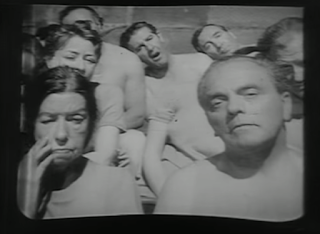** this review contains spoilers (for one of the most-spoiled films) **
In the 1960s, the rules known as political correctness were in process, which makes some of the classic films of the era problematic for today's hypersensitive viewers. For example: the original
Planet of the Apes, one of the best films of the decade.
As Eric Greene establishes in his book
Planet of the Apes as American Myth, this first film was less specifically racial than the series would become. It begins with Taylor's (Charlton Heston) cynical, timely wish for something "better than man." Unfortunately for him (and like co-star Roddy McDowall in the
Twilight Zone episode of the same name), he finds that "people are alike all over" -- even when they're apes.
The film arguably satirizes liberals of its time: the apes are hairy, wear leather and live in commune-like villages. Though divided by species and corresponding behavior (gorilla, chimpanzee, orangutan), all disdain humans, who therefore parallel old-line conservatives, with both (considered) bypassed by evolution.
 |
| "You may not like what you find." |
Greene's book, brilliant as it is at times, is an index of how far we've fallen since 1968. He ties himself in knots trying to lift the films
and counter their dim view of humanity. A good leftist and multiracial in heritage, Greene feels white people are almost entirely to blame (and not just historically), with reverse racism a (suburban) legend. He answers white paranoia with equally far-fetched, utopian multiculturalism.
The recent
Planet of the Apes reboot (
Rise and
Dawn) is similarly contorted.
Rise wasn't bad, but
Dawn is pointless: whereas the original films have no real heroes,
Dawn founders as good and bad people interact with good and bad apes. With the satire muddied, we might wonder why we're watching apes in the first place. I suspect these neo-
Apes films exist because younger viewers realize there's something of value in the originals, but prefer softened versions.
Fantasy is a natural for race themes; both racial tensions and fantasy concern our attraction to/fear of the other. The early 20th century had tales of lost worlds and races culminating in
King Kong (1933), viewed by some as an allegory of slavery. Ralph Ellison answered H.G. Wells by claiming "the invisible man" as metaphor for the black experience. If the original
Apes film
-cycle equates black people with apes, it's only because the white imagination has always done the same. The fiction of speaking apes allows an interrogation of racial anxieties. Given approaching white minority, perhaps a film will reverse the scheme. (Some might enjoy seeing the current president as an orangutan, orange comb-over included.)
Planet of the Apes opened 3 April 1968, the day before Martin Luther King, Jr. was assassinated. I'm not sure I've read a review that mentions this, probably because it might be misunderstood, but it must have made the transgressive film an especially dislocating experience.
As the narrative begins, the desiccated corpse of the human crew's sole female implies -- it's over. The white -- uh, human race is over. Taylor shouldn't mind, given his cynicism, but the story will reduce him to Biblical grief.
 |
| "She was going to be the new Eve." |
Over the five-film series, it's revealed the ape power structure doesn't
disbelieve human intelligence, they just want to cover it up. This branches into struggles over evolution, speech, and literacy (both ape and human). All of it seems to prefigure the furor over Barack Obama being "articulate" and then the "birther" conspiracy-thought. With Obama's intelligence unavoidable, the matter of legitimacy got bumped to matters of birth and record-keeping. Some think of the original film as embarrassing artifact. It could've been made yesterday, if we had the courage of Arthur Jacobs, Franklin Schaffner, Michael Wilson, Rod Serling, Charlton Heston, Roddy McDowall, and Kim Hunter.
The above-named were over 40 in 1968. Baby Boomers were more optimistic, but motivated by the fact every generation drifts back to the norms of that prior: we become our parents. For Boomers, this meant intolerable hypocrisy. Even as the Civil Rights Movement seemed to triumph, white Americans fled en masse to the (white) suburbs, and American men were sent to fight in a seemingly insignificant Asian country.
At home, a rebellious generation attempted to blow up the timeline with sex-drugs-rock-n-roll (and to a lesser extent, with bombs). It didn't work, they had kids, and bent to whisper: "When you grow up you're going to make the world
such a better place." Making the world better means change, and so the new apes films must be
different from the originals. It feels like change.
 Watching 1970s TV for my series on Pop Matters, it felt vaguely like walking the site of a war crime. As a film buff I'd heard the stories, perhaps most memorable was Christine Lahti's, of a proposition rebuffed when she was young and struggling. The showbiz sleaze told her, "You'd better do something, you're not that pretty."
Watching 1970s TV for my series on Pop Matters, it felt vaguely like walking the site of a war crime. As a film buff I'd heard the stories, perhaps most memorable was Christine Lahti's, of a proposition rebuffed when she was young and struggling. The showbiz sleaze told her, "You'd better do something, you're not that pretty."
















